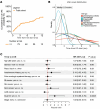Immune-related events in individuals with solid tumors on immunotherapy associate with Th17 and Th2 signatures
- PMID: 39403935
- PMCID: PMC11473156
- DOI: 10.1172/JCI176567
Immune-related events in individuals with solid tumors on immunotherapy associate with Th17 and Th2 signatures
Abstract
BACKGROUNDImmune-related adverse events (irAEs) and their associated morbidity/mortality are a key concern for patients receiving immune checkpoint inhibitors (ICIs). Prospective evaluation of the drivers of irAEs in a diverse pan-tumor cohort is needed to identify patients at greatest risk and to develop rational treatment and interception strategies.METHODSIn an observational study, we prospectively collected blood samples and performed regular clinical evaluations for irAEs in patients receiving ICI therapy as standard of care for solid tumors. We performed in-parallel analysis of cytokines by Luminex immunoassay and circulating immune cells by cytometry by time-of-flight (CyTOF) at baseline and on treatment to investigate mechanisms of irAEs.RESULTSWe enrolled 111 patients, of whom 40.5% developed a symptomatic irAE (grade ≥ 2). Development of a grade ≥ 2 irAE was positively associated with the use of combination ICI and a history of an autoimmune disorder. Early changes in T helper 17 (Th17) (IL-6, IL-17f), type 2 (IL-5, IL-13, IL-25), and type 1 (TNF-α) cytokine signatures and congruent on-treatment expansions of Th17 and Th2 effector memory (Th2EM) T cell populations in peripheral blood were positively associated with the development of grade ≥2 irAEs. IL-6 levels were also associated with inferior cancer-specific survival and overall survival.CONCLUSIONSIn a diverse, prospective pan-tumor cohort, Th17 and Th2 skewing during early ICI treatment was associated with the development of clinically relevant irAEs but not antitumor responses, providing possible targets for monitoring and therapeutic interventions.FUNDINGJohns Hopkins Bloomberg-Kimmel Institute for Cancer Immunotherapy, the NCI SPORE in Gastrointestinal Cancers (P50 CA062924), NCI grant (R50CA243627 to LD), the NIH Center Core Grant (P30 CA006973), Swim Across America (to MY), NIAMS (K23AR075872 to LC), and imCORE-Genentech grant 137515 (to Johns Hopkins Medicine on behalf of MY).
Keywords: Cytokines; Immunotherapy; Oncology; T cells.
Figures








Comment in
- Distinguishing between help and harm: Helper T cell subsets and immune-related adverse events
References
Publication types
MeSH terms
Substances
Grants and funding
LinkOut - more resources
Full Text Sources
Medical
Research Materials

